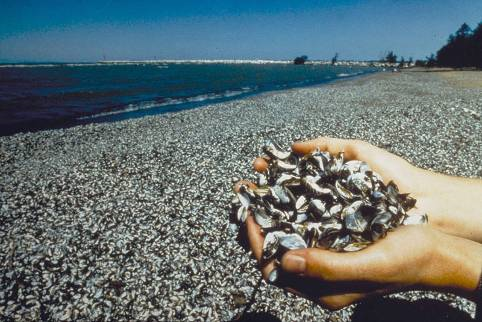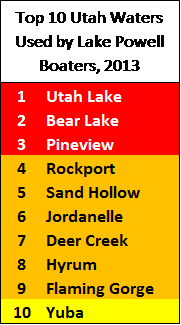Fiscal Highlights - May 2014
|
How Will Quagga Mussel Impact Utah Financially? -
Ivan D. Djambov ( Now that the invasive quagga mussels are established in Lake Powell, how long before they get to other Utah waters, and how much will it cost Utah taxpayers each year to mitigate for the damages they cause? The quagga mussels spread very fast. A female produces up to a million larvae per year, and the mussels do not have many natural predators in North America. Adult quagga can also survive 3-5 days out of the water in summer temperatures. Small in size (adult mussels are no larger than an adult's thumbnail), the quagga mussel colonies can grow so close together that they cover the entire bottom of a lake. They block off pipelines and screens for culinary water, sanitation, intakes to power plants and irrigation. The mussels also degrade the water flavor for drinking water facilities, clog up sprinklers at golf courses, impact fisheries, and require extra repairs and maintenance for boat owners. For infested states, the costs to live with quagga is hundreds of millions of dollars per year.
Source: http://greatlakesoutdoors.wordpress.com
How Fast Will They Spread? It took six years for the quagga mussel to get from Lake Mead to Lake Powell. The logical questions are: how long before they infest the next body of water in Utah and which body of water will it be? The primary ways of spread of the mussel are through boats and canals/pipes. With Lake Powell being downstream to Utah on the Colorado River, and the Lake Powell pipeline not yet constructed, the most likely way of spreading the quagga in Utah is boats. The 2014 boating season in Lake Powell has already started. It is common for boaters who spend time in Lake Powell to visit other bodies of water in Utah either on their way home or within the following week or two. What are these bodies of water? The table below provides the top ten waters in Utah used by Lake Powell boaters in 2013.
According to the Division of Wildlife Resources, the top three destinations in 2013 for boaters coming from Lake Powell were Utah Lake, Bear Lake, and Pineview Reservoir. Statistically, these are the most likely waters to be infested next with quagga. However, since thousands of boats from Lake Powell are used all over Utah, and since it takes only one vessel carrying the mussel or its larvae to spread it, there are no guarantees for any other water body in Utah. The speed of the quagga invasion will depend on the effectiveness of the state's efforts to slow the spread and the willingness of the boaters to do their part. How Much More Will Utah Taxpayers Have to Pay? The economic impact of quagga to Utah is going to be significant. There will be direct additional costs to water users, power-generation facilities, and agriculture to mitigate for blocked pipelines and screens, intakes to power plants, and irrigation. There will also be additional economic impacts to the state as a result of the loss of revenue to Utah's tourism, fishing and recreation industries. Based on the actual costs incurred by eastern states infested with quagga, the Division of Water Resources has estimated that the additional costs will be over $21 million per year for maintenance and mitigation (see table below). This figure does not include the costs for cleaning pipelines (over 1,120 miles), canals (7,700 miles), and secondary water systems, because these costs are yet to be identified.
These cost estimates are based on the assumption that all major bodies of water in Utah are infested with quagga, which has not yet happened, but according to the experts, it is just a matter of time. |
$107 Million of Excess Federal TANF Spending Authority - Stephen C. Jardine The Department of Workforce Services (DWS) administers the federal Temporary Assistance for Needy F...Division of Air Quality: New Appropriations Update - Angela J. Oh Air quality was a priority during the 2014 General Session. Lawmakers passed legislation to cut emi...DJJS - Receiving Centers and Youth Services - Zackery N. King What is the next step for receiving centers and youth services? Receiving centers and youth s...Economic Development Incentives - Andrea Wilko Financial incentives are provided through the Utah Governor's Office of Economic Development and th...Higher Education Tuition Increases for 2014-2015 - Spencer C. Pratt Following the 2014 General Session, the State Board of Regents met and approved a 4.0% first-tier t...How Will Quagga Mussel Impact Utah Financially? - Ivan D. Djambov Now that the invasive quagga mussels are established in Lake Powell, how long before they get to ot...Is there a Relationship between Educational Attainment and Employment Growth? - Thomas E. Young The Education Interim Committee heard presentations on long-term planning for educational attainmen...Jail Reimbursement Program and Appropriations - Fiscal Years 2011-15 - Gary K. Ricks The Jail Reimbursement Program provides reimbursement to Utah counties for days spent in county jai...Medicaid and CHIP Enrollment Trends Since the Beginning of Mandatory Medicaid Expansion - Russell T. Frandsen Since the beginning of the Medicaid mandatory expansion as part of federal health care reform in Ja...Sequestration Update - Steven M. Allred In December 2013, Congress passed the Bipartisan Budget Act of 2013 (BBA), providing states some ce...The Billion Dollar Retirement Gap - Brian D. Fay In 2008, the Utah Retirement System (URS) experienced investment losses of nearly 25 percent, leavi... |
Reports/Archive | Budget Process | Office Background | Who's Who | Organization Chart
Office of the Legislative
Fiscal Analyst
House Building, Suite W310
Salt Lake City, UT 84114
Phone (801) 538-1034 Fax (801) 538-1692

 Source: usbr.gov
Source: usbr.gov Source: examiner.com
Source: examiner.com Source: marronebioinnovations.com
Source: marronebioinnovations.com
